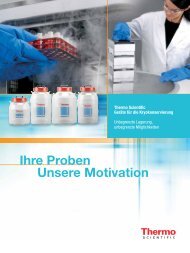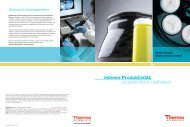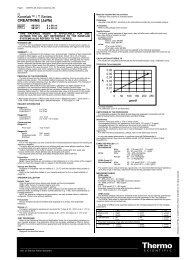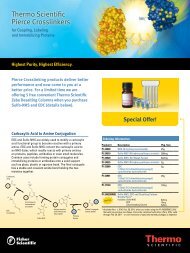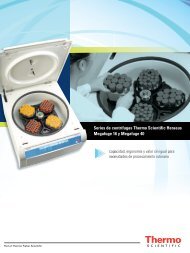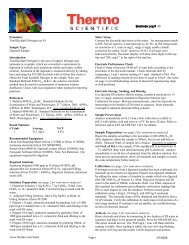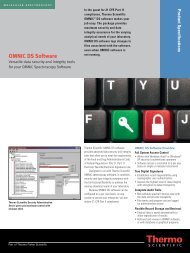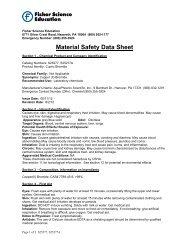Detecting Campylobacter Contamination in Food: New O.B.I.S. ...
Detecting Campylobacter Contamination in Food: New O.B.I.S. ...
Detecting Campylobacter Contamination in Food: New O.B.I.S. ...
You also want an ePaper? Increase the reach of your titles
YUMPU automatically turns print PDFs into web optimized ePapers that Google loves.
Summer 2008<br />
A Widespread Disease<br />
<strong>Campylobacter</strong> is the lead<strong>in</strong>g cause of<br />
enteric disease <strong>in</strong> most Western countries<br />
and is the most common bacterial<br />
cause of diarrheal illness <strong>in</strong> the United<br />
States. <strong>Campylobacter</strong> species differ<br />
from other foodborne pathogens <strong>in</strong> that<br />
they do not multiply with<strong>in</strong> the food.<br />
However, as few as 500 cells are sufficient<br />
to cause <strong>in</strong>fection. Most frequently,<br />
poultry and cattle are the sources of<br />
human <strong>in</strong>fection, but puppies, kittens,<br />
pigs, sheep, rodents, and birds may also<br />
serve as reservoirs. In fact, most cases<br />
of <strong>Campylobacter</strong>iosis are associated<br />
with handl<strong>in</strong>g raw poultry or eat<strong>in</strong>g raw<br />
or undercooked poultry meat.<br />
<strong>Campylobacter</strong>iosis is a serious disease;<br />
even when caus<strong>in</strong>g only a self-limit<strong>in</strong>g<br />
<strong>in</strong>fection, the economic effect can be<br />
huge. The worldwide commercial cost of<br />
the disease associated with poultry<br />
alone has been estimated at between<br />
$400 and $800M annually. The pathogen<br />
can be transmitted from animal to<br />
person, through <strong>in</strong>gestion of fecally contam<strong>in</strong>ated<br />
water or food, or by direct<br />
contact with contam<strong>in</strong>ated environmental<br />
surfaces. Therefore, key markets for<br />
test<strong>in</strong>g are the poultry and meat <strong>in</strong>dustries<br />
as well as milk and water process<strong>in</strong>g<br />
facilities.<br />
S<strong>in</strong>ce as few as 500 organisms can lead<br />
to disease, test<strong>in</strong>g methods must be<br />
Stop by and check out Fisher Scientific's booth at the IAFP Annual Meet<strong>in</strong>g—<br />
August 3-6 <strong>in</strong> Columbus, Ohio.<br />
<strong>Detect<strong>in</strong>g</strong> <strong>Campylobacter</strong> <strong>Contam<strong>in</strong>ation</strong> <strong>in</strong> <strong>Food</strong>: <strong>New</strong> O.B.I.S. Campy Kit<br />
By: Christ<strong>in</strong>e Hilbert, Ph.D., Industrial Product Manager, Remel Brand Products<br />
sensitive enough to detect these low<br />
numbers of organisms. In addition, to<br />
m<strong>in</strong>imize outbreaks of <strong>Campylobacter</strong><br />
and other food pathogens, rapid detection<br />
methods are needed. Such methodology<br />
can lead to sav<strong>in</strong>gs of hundreds of<br />
millions of dollars annually by m<strong>in</strong>imiz<strong>in</strong>g,<br />
or even elim<strong>in</strong>at<strong>in</strong>g, both food<br />
recalls and disease outbreaks and the<br />
associated costs.<br />
Current methods<br />
Current test<strong>in</strong>g methods typically <strong>in</strong>volve<br />
an enrichment step followed by plat<strong>in</strong>g<br />
and confirmation, tak<strong>in</strong>g up to one week<br />
to verify <strong>Campylobacter</strong> contam<strong>in</strong>ation.<br />
This is primarily due to the fact that isolation<br />
from food is difficult because the<br />
bacteria are usually present <strong>in</strong> very low<br />
numbers.<br />
These methods require an enrichment<br />
broth conta<strong>in</strong><strong>in</strong>g antibiotics, special<br />
antibiotic conta<strong>in</strong><strong>in</strong>g plates and a<br />
microaerophilic atmosphere (generally<br />
with 5% oxygen and an elevated concentration<br />
of carbon dioxide at 10%).<br />
Isolation us<strong>in</strong>g these methods can take<br />
from several days to a week. In addition,<br />
isolation of the organism from highly<br />
contam<strong>in</strong>ated samples may require different<br />
selective media dependent on the<br />
food type and with <strong>in</strong>cubation under<br />
microaerobic conditions. They are not<br />
the fastest-grow<strong>in</strong>g organisms – it can<br />
still take up to a week to obta<strong>in</strong> a f<strong>in</strong>al<br />
test result.<br />
Follow<strong>in</strong>g isolation on selective media,<br />
identification must be carried out us<strong>in</strong>g<br />
biochemical, immunological and molecular<br />
techniques, <strong>in</strong>clud<strong>in</strong>g:<br />
• Biochemical profiles can be obta<strong>in</strong>ed;<br />
however, biochemical activity of<br />
<strong>Campylobacter</strong> organisms has been<br />
reported to be low.<br />
• Immunological techniques such as<br />
antibody/antigen <strong>in</strong>teractions; e.g.,<br />
latex agglut<strong>in</strong>ation.<br />
• Molecular methods us<strong>in</strong>g PCR or<br />
nucleic acid techniques have been<br />
reported and are the subject of current<br />
research studies.<br />
• Cl<strong>in</strong>ical samples; usually referred to<br />
specialist laboratories for serotyp<strong>in</strong>g<br />
and antibiotic sensitivity test<strong>in</strong>g.<br />
Rapid confirmation<br />
To address the need for a rapid, sensitive<br />
test for confirmation of<br />
<strong>Campylobacter</strong> contam<strong>in</strong>ation, a new<br />
rapid screen<strong>in</strong>g kit for the detection of<br />
<strong>Campylobacter</strong>aceae has been <strong>in</strong>troduced.<br />
This kit, referred to as O.B.I.S.<br />
campy (Oxoid Biochemical Identification<br />
System for <strong>Campylobacter</strong>), provides an<br />
easy-to-use rapid test<strong>in</strong>g solution for the<br />
detection of <strong>Campylobacter</strong>aceae, differentiat<strong>in</strong>g<br />
<strong>Campylobacter</strong>aceae from<br />
other organisms with similar colony<br />
morphology.<br />
Cont<strong>in</strong>ued on back cover<br />
Fisher Scientific • www.fishersci.com/food • 1-800-766-7000 1
Clean, Clean, Clean!<br />
By: Tom Seechuk, Market Manager, LaMotte Company<br />
Yes, your mother was right all those<br />
years that she made you wash your<br />
hands every time you touched anyth<strong>in</strong>g<br />
or anybody. And her advice<br />
rema<strong>in</strong>s truer than ever today, <strong>in</strong> light<br />
of all of the bacterial outbreaks that<br />
have been <strong>in</strong> the news. The food and<br />
beverage processors are well aware<br />
of the effects that such outbreaks<br />
can have. Some recalls have actually<br />
forced companies out of bus<strong>in</strong>ess, so<br />
clean<strong>in</strong>g and sanitiz<strong>in</strong>g have become<br />
a high priority <strong>in</strong> this area.<br />
Clean<strong>in</strong>g vs. Sanitiz<strong>in</strong>g<br />
There is a difference between clean<strong>in</strong>g<br />
and sanitiz<strong>in</strong>g. With clean<strong>in</strong>g, one<br />
is primarily deal<strong>in</strong>g with anyth<strong>in</strong>g<br />
from tank cars to kitchen fryers and<br />
greasy areas---basically any place<br />
that might have a buildup of prote<strong>in</strong>s,<br />
soils, etc. There is also a process<br />
called “clean <strong>in</strong> place” (CIP) whereby<br />
chemicals are used to clean bottles<br />
and other packag<strong>in</strong>g components.<br />
For these types of jobs, acid or alkal<strong>in</strong>e<br />
compounds are used. This is<br />
step one (and the most difficult step)<br />
of the clean<strong>in</strong>g process: remov<strong>in</strong>g the<br />
“funky” material so that the surface<br />
can then be sanitized. Once this<br />
organic load is removed, the sanitizers<br />
can do their job more easily.<br />
The type of cleaner and dosage used<br />
depends on the surface (particularly<br />
if metal) that is be<strong>in</strong>g cleaned.<br />
Sta<strong>in</strong>less steel is preferred for food<br />
surfaces, but other metals such as<br />
alum<strong>in</strong>um, z<strong>in</strong>c and iron are sometimes<br />
used and can be corroded by<br />
certa<strong>in</strong> cleaners. Alkal<strong>in</strong>e cleaners<br />
are good for remov<strong>in</strong>g fats, grease,<br />
prote<strong>in</strong>s and most soils. M<strong>in</strong>eral<br />
deposits usually require acid cleaners.<br />
Either type can be used <strong>in</strong> CIP. It<br />
is a good idea to check with the<br />
chemical supplier for the recommended<br />
cleaner.<br />
Strong alkal<strong>in</strong>e cleaners are usually<br />
sodium or potassium hydroxide<br />
based. Weaker ones use trisodium<br />
phosphate, silicate or carbonate<br />
salts. Acid cleaners can use phosphoric,<br />
nitric, sulfamic, sulfuric or<br />
hydrochloric acids. Surfactants can<br />
be added to the cleaners to help the<br />
clean<strong>in</strong>g process and make the<br />
cleaner foam. The foam helps the<br />
contact time.<br />
Check<strong>in</strong>g the Strength of a Cleaner<br />
To check the strength of acid or alkal<strong>in</strong>e<br />
cleaners, it is best to use an<br />
acid-base titration, with a phenolphthale<strong>in</strong><br />
<strong>in</strong>dicator. Rather than buy<strong>in</strong>g<br />
separate kits for different acids,<br />
one can use the 7182 Acidity Test Kit.<br />
This kit <strong>in</strong>cludes titration equivalence<br />
factors for hydrochloric, sulfuric or<br />
phosphoric acids. By us<strong>in</strong>g different<br />
sample sizes it also allows a 1 drop<br />
= 0.1% or 1% equivalence. If other<br />
acids are used, it is easy to convert<br />
to the particular acid.<br />
To titrate caustic soda as sodium<br />
hydroxide (NaOH), one should elim<strong>in</strong>ate<br />
the contribution of any carbonates.<br />
The 7181 Caustic Test Kit uses<br />
barium to precipitate the carbonate,<br />
then a standard acid titrates the<br />
caustic. This kit also uses two sample<br />
sizes for 1 drop = 0.1 or 1%<br />
equivalences. Of course, if one wants<br />
to determ<strong>in</strong>e the strength of the<br />
cleaner with the carbonates, simply<br />
elim<strong>in</strong>ate the barium precipitation.<br />
The three ma<strong>in</strong> chemicals that have<br />
been used over the years for sanitation<br />
are chlor<strong>in</strong>e, quaternary ammonium<br />
compounds (QAC or quats), and<br />
iod<strong>in</strong>e. Other chemicals such as chlor<strong>in</strong>e<br />
dioxide, peracetic acid and peroxide<br />
have recently ga<strong>in</strong>ed <strong>in</strong> popularity,<br />
but chlor<strong>in</strong>e, QAC and iod<strong>in</strong>e<br />
are still the most common sanitizers.<br />
Chlor<strong>in</strong>e<br />
Chlor<strong>in</strong>e can be used <strong>in</strong> a variety of<br />
forms. Usually bleach solutions are<br />
diluted to the required usage level.<br />
The key factors for efficacy are pH<br />
(the lower, the more active the chlor<strong>in</strong>e)<br />
and temperature (the higher, the<br />
more active). In the produce area,<br />
50-200ppm is the usual concentration<br />
for spray<strong>in</strong>g or clean<strong>in</strong>g fruits<br />
and vegetables. In poultry process<strong>in</strong>g,<br />
workers dip implements, gloves<br />
and boots <strong>in</strong> 200 or more ppm chlor<strong>in</strong>e<br />
solutions. Higher organic load<br />
areas <strong>in</strong> these plants sometimes<br />
require up to 800ppm or more.<br />
Chlor<strong>in</strong>e is also used <strong>in</strong> the chiller<br />
water to reduce contam<strong>in</strong>ation.<br />
Contact surfaces require 50-200ppm<br />
chlor<strong>in</strong>e. Above 200ppm, the surface<br />
should be r<strong>in</strong>sed. S<strong>in</strong>ce chlor<strong>in</strong>e is<br />
corrosive, caution should be used on<br />
such surfaces. Chlor<strong>in</strong>e is used <strong>in</strong> the<br />
dairy <strong>in</strong>dustry to r<strong>in</strong>se milk<strong>in</strong>g<br />
mach<strong>in</strong>es and <strong>in</strong> the egg <strong>in</strong>dustry to<br />
clean eggs. The 4250-BJ is an easyto-use<br />
test paper that has values of<br />
10, 50, 100 and 200ppm chlor<strong>in</strong>e. The<br />
3031 is a high-range chlor<strong>in</strong>e test<br />
strip that can read to 800ppm.<br />
Quaternary Ammonium Compounds<br />
Quats are not as efficaceous as chlor<strong>in</strong>e,<br />
but are less noxious and tend to<br />
cl<strong>in</strong>g to surfaces better. This is their<br />
primary use. Their tendency to foam<br />
helps with surface clean<strong>in</strong>g, but this<br />
can be a drawback. Quats are better<br />
<strong>in</strong> kill<strong>in</strong>g gram-positive bacteria than<br />
negative. Orig<strong>in</strong>ally, only simple quats<br />
were used. These were based on<br />
various forms of alkyl dimethyl benzyl<br />
ammonium chloride, which was<br />
referred to as ADBAC. But soon,<br />
researchers were comb<strong>in</strong><strong>in</strong>g various<br />
cha<strong>in</strong>s to make more complex quats,<br />
now referred to as 4th and 5th gen-<br />
eration, that are safer to use, have<br />
better efficacy and foam less.<br />
The usual quat concentration is 100-<br />
400ppm, depend<strong>in</strong>g on use. As with<br />
chlor<strong>in</strong>e, they are used <strong>in</strong> many food<br />
process<strong>in</strong>g operations and can<br />
exceed 1,000ppm <strong>in</strong> some food plant<br />
areas. They, too, are used <strong>in</strong> the dairy<br />
and egg <strong>in</strong>dustries. The 2951 strips<br />
read all types of QAC. There are 2<br />
ranges – the 2951 reads 0-400ppm;<br />
and the 2951HR reads 0-1,500ppm.<br />
Iod<strong>in</strong>e<br />
Iod<strong>in</strong>e is more specialized and thus<br />
used less than chlor<strong>in</strong>e or QAC. It is<br />
used frequently <strong>in</strong> restaurant warewash<br />
applications. It sanitizes warewash<br />
and helps with a sheet<strong>in</strong>g<br />
action to prevent drops on glasses.<br />
Health codes usually call for a range<br />
of 12.5-25ppm iod<strong>in</strong>e for warewash,<br />
but because iod<strong>in</strong>e vaporizes at<br />
120ºF, the washers must be run at<br />
lower temperatures.<br />
Iod<strong>in</strong>e can also be used where chlor<strong>in</strong>e<br />
is too corrosive. Here the concentration<br />
can be 40-50ppm, but<br />
contact time is longer. It is frequently<br />
used <strong>in</strong> the w<strong>in</strong>e and beer <strong>in</strong>dustries.<br />
The ma<strong>in</strong> problem with regular use<br />
or longer contact time is sta<strong>in</strong><strong>in</strong>g.<br />
However, it usually does not need to<br />
be r<strong>in</strong>sed from conta<strong>in</strong>ers before use.<br />
Because of the no-r<strong>in</strong>se requirement,<br />
it is ideal for milk<strong>in</strong>g operations. The<br />
2948-BJ strips read from 12-100ppm<br />
iod<strong>in</strong>e. There are also field titration<br />
kits for iod<strong>in</strong>e.<br />
Assur<strong>in</strong>g a Safe Product<br />
The food and beverage process<br />
areas perform two tasks to assure<br />
safe product: clean then sanitize. The<br />
field kits and strips described here<br />
help the plant to make sure that<br />
these goals are achieved quickly<br />
and easily.<br />
2 • www.fishersci.com/food • 1-800-766-7000 Fisher Scientific
Ohaus ® FD Series <strong>Food</strong> Scales: Ensur<strong>in</strong>g Accurate Portion Control<br />
By: Jason Ledder, R&J Public Relations. Article courtesy of Ohaus Corporation<br />
At Rockne’s Restaurant <strong>in</strong> suburban<br />
Fairlawn, Ohio, where d<strong>in</strong>ers are<br />
<strong>in</strong>vited to enjoy “great food and fun,”<br />
General Manager Ann Lord and her<br />
staff arrive at the establishment well<br />
before its 11 a.m. open<strong>in</strong>g to prepare<br />
for their lunch and d<strong>in</strong>ner guests.<br />
One of the many th<strong>in</strong>gs the employees<br />
do dur<strong>in</strong>g those early hours is to<br />
weigh out dozens of foods that are<br />
featured on the menu.<br />
Portion Control: A Key to<br />
Profitability<br />
“Restaurants live and die by portion<br />
control,” Lord says. “Consistent portions<br />
help <strong>in</strong>sure customer satisfaction<br />
and contribute to the restau-<br />
In one of the hottest environments <strong>in</strong><br />
the world, keep<strong>in</strong>g ice cream cool<br />
and frozen can be a difficult task. A<br />
lead<strong>in</strong>g manufacturer of ice cream <strong>in</strong><br />
Dubai uses a network of Dickson<br />
data loggers to monitor this task.<br />
Their goal is to monitor temperatures<br />
and deliver sweet frozen treats<br />
across the Middle East.<br />
Constant monitor<strong>in</strong>g is a necessity,<br />
with outdoor temperatures rout<strong>in</strong>ely<br />
exceed<strong>in</strong>g 90°F. The monitor<strong>in</strong>g solu-<br />
rant’s profitability,” she cont<strong>in</strong>ues.<br />
For example, d<strong>in</strong>ers want to feel they<br />
are receiv<strong>in</strong>g value and, consequently,<br />
Rockne’s risks los<strong>in</strong>g these<br />
customers if they are served different-sized<br />
portions on separate visits.<br />
Additionally, Lord said, a restaurant’s<br />
profit decreases if extra food is<br />
served due to <strong>in</strong>accurate portion<br />
control.<br />
On this particular morn<strong>in</strong>g, the l<strong>in</strong>e<br />
cooks at Rockne’s meticulously<br />
weigh out portions of cooked foods,<br />
such as turkey and other deli meat,<br />
tuna salad, chicken stir-fry, chicken<br />
salad, vegetables, beef taco melt and<br />
even fruit for fruit salad. On days<br />
when large food shipments arrive,<br />
the cooks also portion frozen appetizers<br />
by weight. While recipe <strong>in</strong>gredients<br />
are occasionally weighed, the<br />
majority of the activity is centered<br />
around cooked food.<br />
The Ohaus FD Series <strong>Food</strong> Scale<br />
With such a busy back-of-the-house<br />
operation, the workers appreciate<br />
Keep<strong>in</strong>g the Ice <strong>in</strong> Ice Cream<br />
By: Article courtesy of Dickson<br />
tion must have the ability to log past<br />
data to meet government regulations,<br />
but also allow Quality Assurance<br />
Officials the ability to view current<br />
conditions. This is necessary so<br />
action can be taken if environmental<br />
conditions change. It must also allow<br />
staff to react and save <strong>in</strong>ventory or<br />
fix a potential problem.<br />
Convenient Monitor<strong>in</strong>g Solution<br />
The solution is a network of Dickson<br />
Data Loggers connected by a multiple<br />
po<strong>in</strong>t monitor (SM325 with<br />
MP100). This comb<strong>in</strong>ation saves the<br />
facility manpower by not hav<strong>in</strong>g to<br />
download <strong>in</strong>dividual data loggers and<br />
is an easy way to document all environmental<br />
conditions.<br />
With this configuration, QA officials<br />
are able to monitor all n<strong>in</strong>e cool<br />
rooms from one central location.<br />
equipment that is durable, and easy<br />
to set up and use. Lord says that the<br />
Ohaus FD Series food scales meet<br />
these requirements and more. The<br />
staff also likes the scale’s easy-toread,<br />
large, backlit LCD display and<br />
the option to select from several<br />
weigh<strong>in</strong>g units like ounces or<br />
pounds.<br />
The FD Series also provides fast and<br />
accurate results with<strong>in</strong> two seconds.<br />
“The scales are very exact – it’s easy<br />
to get what you are look<strong>in</strong>g for,” Lord<br />
adds. Ease of use is also an important<br />
factor. “They are very simple to<br />
use,” she says. “All you have to do is<br />
turn them on and recharge them<br />
occasionally. And they are easy to<br />
clean up and put away.”<br />
Solid Construction; Portable<br />
Design<br />
To meet str<strong>in</strong>gent cleanl<strong>in</strong>ess<br />
requirements <strong>in</strong> food preparation, the<br />
FD Series scale features a sta<strong>in</strong>lesssteel<br />
top and bottom hous<strong>in</strong>g as well<br />
From one s<strong>in</strong>gle po<strong>in</strong>t, employees are<br />
able to view current conditions, log<br />
past read<strong>in</strong>gs, and present reports<br />
for government officials. It also<br />
allows for a quick response <strong>in</strong> order<br />
to save valuable <strong>in</strong>ventory.<br />
Disposable Chart Recorders<br />
While monitor<strong>in</strong>g their storerooms is<br />
essential, this dairy company also<br />
needs a solution for their transportation<br />
logistics system. They export ice<br />
cream across the Middle East, from<br />
Saudi Arabia to Kuwait and need to<br />
monitor the trucks to ensure proper<br />
conditions are ma<strong>in</strong>ta<strong>in</strong>ed dur<strong>in</strong>g<br />
transportation. To accomplish this,<br />
they use Dickson disposable chart<br />
recorders (D301). These convenient,<br />
accurate recorders allow for s<strong>in</strong>gle<br />
use and also provide an economical<br />
solution.<br />
as a removable sta<strong>in</strong>less-steel pan.<br />
Designed for maximum portability, it<br />
<strong>in</strong>cludes an <strong>in</strong>ternal rechargeable<br />
battery which can run for more than<br />
120 hours before requir<strong>in</strong>g a<br />
recharge. It can also be used<br />
throughout the week on a s<strong>in</strong>gle<br />
overnight recharge.<br />
Lord turned to the Ohaus scales<br />
about four years ago. “We had been<br />
go<strong>in</strong>g through scales left and right,”<br />
she expla<strong>in</strong>s. We needed to f<strong>in</strong>d reliable<br />
equipment.” She tried the Ohaus<br />
FD Series scale and was pleased<br />
with its dependability. Rockne’s now<br />
has three such scales <strong>in</strong> their restaurant<br />
kitchen.<br />
Rockne’s has been able to reta<strong>in</strong><br />
customers while keep<strong>in</strong>g food costs<br />
constant through the use of Ohaus<br />
FD Series scales <strong>in</strong> its kitchens. Lord<br />
said this weigh<strong>in</strong>g process has<br />
improved the d<strong>in</strong>er “experience” as<br />
the restaurant cha<strong>in</strong> is able to ma<strong>in</strong>ta<strong>in</strong><br />
consistency – a key factor <strong>in</strong> a<br />
very competitive <strong>in</strong>dustry.<br />
In addition, the trucks travel on some<br />
rough roads, so they require a product<br />
that can handle rugged driv<strong>in</strong>g<br />
conditions. The chart recorders not<br />
only provide shock and vibration protection,<br />
but also are tamper-proof<br />
and have a pull-out start tab for failsafe<br />
startup. These features provide<br />
an ideal solution for cold-cha<strong>in</strong><br />
monitor<strong>in</strong>g.<br />
When critical conditions for food<br />
safety exist, many <strong>Food</strong> Service<br />
Professionals have had positive<br />
results with Dickson Data Loggers.<br />
They offer ease of use, a high degree<br />
of accuracy, and a proven track<br />
record for solv<strong>in</strong>g difficult, complex<br />
customer issues.<br />
Fisher Scientific • www.fishersci.com/food • 1-800-766-7000 3
<strong>Detect<strong>in</strong>g</strong> <strong>Campylobacter</strong> <strong>Contam<strong>in</strong>ation</strong> <strong>in</strong> <strong>Food</strong>: <strong>New</strong> O.B.I.S. Campy Kit<br />
Cont<strong>in</strong>ued from front cover<br />
O.B.I.S. Campy is a simple, rapid, colorimetric<br />
test for the detection of L-alanyl<br />
am<strong>in</strong>opeptidase, an enzyme present <strong>in</strong><br />
most Gram-negative organisms but<br />
absent <strong>in</strong> <strong>Campylobacter</strong>, Helicobacter<br />
and Arcobacter species. It has been<br />
designed to differentiate these three<br />
species from other Gram-negative<br />
organisms and also <strong>in</strong>corporates a<br />
Gram-lysis test which will quickly and<br />
easily demonstrate Gram status.<br />
Each kit is sufficient for 60 enzymatic<br />
tests (<strong>in</strong>clud<strong>in</strong>g sufficient NaOH for up to<br />
600 screens). Included <strong>in</strong> the kit are ten<br />
test cards, each with six separate reaction<br />
zones, Campy buffer (7mL) , DMAC<br />
developer (7mL), NaOH (for Gram lysis<br />
test, 6mL), and 60 paddle pastettes. The<br />
kit has a 12-month shelf life and is<br />
stored at 2-8°C. It has 100% sensitivity<br />
and 99.6% specificity, demonstrat<strong>in</strong>g its<br />
ability to accurately differentiate<br />
<strong>Campylobacter</strong> spp. from other contam<strong>in</strong>at<strong>in</strong>g<br />
organisms. This easy-to-use, simple<br />
methodology is an <strong>in</strong>expensive way<br />
to rapidly confirm if <strong>Campylobacter</strong> contam<strong>in</strong>ation<br />
is present.<br />
Test<strong>in</strong>g Pr<strong>in</strong>ciple<br />
The O.B.I.S. campy test will differentiate<br />
species of <strong>Campylobacter</strong>, Helicobacter<br />
and Arcobacter from all other Gramnegative<br />
organisms. Unlike other Gram<br />
negative organisms,<br />
<strong>Campylobacter</strong>aceae do not possess the<br />
enzyme L-alanyl am<strong>in</strong>opeptidase<br />
(L-ALA). The O.B.I.S. campy test <strong>in</strong>corporates<br />
a rapid test to detect this<br />
enzyme and a Gram-lysis reagent to<br />
rapidly determ<strong>in</strong>e the Gram status.<br />
First, the Gram-lysis test (or a Gram<br />
sta<strong>in</strong>) must be carried out. This test differentiates<br />
between Gram-positive and<br />
Gram-negative bacteria. The test is carried<br />
out on a glass slide. Sodium<br />
Hydroxide (0.5M) is used to lyse the cell<br />
wall of Gram-negative organisms and<br />
release the DNA. The DNA forms a<br />
“str<strong>in</strong>g” which can be seen when the<br />
loop is raised from the surface of the<br />
slide. This reaction does not occur with<br />
Gram-positive organisms.<br />
Once the organism has been identified<br />
as Gram-negative, the L-ALA test can be<br />
carried out. Enclosed reaction cards<br />
have been impregnated with the L-ALA<br />
substrate (L-alanyl-7-am<strong>in</strong>o-4methylcoumar<strong>in</strong>)<br />
<strong>in</strong> each of the six reaction<br />
zones. An acidic solution of dimethylam<strong>in</strong>oc<strong>in</strong>namaldehyde<br />
(DMAC) is used<br />
as a color developer. If this substrate is<br />
hydrolyzed by the organism, the result<strong>in</strong>g<br />
free 7-am<strong>in</strong>o-4-methylcoumar<strong>in</strong> will<br />
comb<strong>in</strong>e with the developer to produce a<br />
purple-colored Schiff’s base.<br />
L-alanyl am<strong>in</strong>opeptidase (L-ALA) is an<br />
enzyme which cleaves L-alan<strong>in</strong>e from<br />
various peptides. It is found <strong>in</strong> the bacterial<br />
cell wall of most Gram-negative<br />
organisms but rarely <strong>in</strong> Gram-positives.<br />
The O.B.I.S. campy kit aids <strong>in</strong> the differentiation<br />
of <strong>Campylobacter</strong> spp. from<br />
other organisms by screen<strong>in</strong>g out all<br />
Gram-positive, and all Gram-negative,<br />
L-ALA positive organisms.<br />
Summary:<br />
For more <strong>in</strong>formation about this product, call Remel Technical Service at 1-800-447-3641 or contact your Fisher Scientific sales representative.<br />
Rely on for quality you can see.<br />
With the recent publicity regard<strong>in</strong>g foodrelated<br />
outbreaks and illnesses, now is<br />
the time to respond with rapid, reliable<br />
solutions. <strong>Campylobacter</strong> is the lead<strong>in</strong>g<br />
cause of enteric disease <strong>in</strong> the United<br />
States. Test<strong>in</strong>g methods must be sensitive<br />
enough to detect low numbers of<br />
organisms, s<strong>in</strong>ce as few as 500 organisms<br />
can lead to disease. To m<strong>in</strong>imize<br />
outbreaks of <strong>Campylobacter</strong> and other<br />
food pathogens, rapid detection methods<br />
are needed. Such methodology can lead<br />
to sav<strong>in</strong>gs of hundreds of millions of dollars<br />
annually by m<strong>in</strong>imiz<strong>in</strong>g, or even<br />
elim<strong>in</strong>at<strong>in</strong>g, both food recalls and disease<br />
outbreaks and the associated<br />
costs. To address this need, a new rapid<br />
screen<strong>in</strong>g kit for the detection of<br />
<strong>Campylobacter</strong>aceae has been <strong>in</strong>troduced.<br />
The kit, O.B.I.S. campy, provides<br />
an easy-to-use rapid test<strong>in</strong>g solution for<br />
the detection of <strong>Campylobacter</strong>aceae. It<br />
allows rapid confirmation of contam<strong>in</strong>ation,<br />
m<strong>in</strong>imiz<strong>in</strong>g risk, result<strong>in</strong>g <strong>in</strong> product<br />
be<strong>in</strong>g released to market sooner, and<br />
ultimately lead<strong>in</strong>g to a safer food supply.<br />
If you ask our employees, quality is<br />
more than a process — it’s a<br />
passion. For more than 35 years<br />
we have been provid<strong>in</strong>g quality<br />
products, rapid delivery, and superior<br />
customer support to exceed<br />
our customers’ expectations.<br />
Learn more at the new remel.com<br />
Part of Thermo Fisher Scientific<br />
Resize <strong>Food</strong>Track_Quality "Me" 1/2pg 060108.<strong>in</strong>dd 1 5/15/08 1:27:02 PM<br />
4 BN0918071 • www.fishersci.com/food • 1-800-766-7000 Fisher Scientific<br />
© 2008 Thermo Fisher Scientific Inc. All rights reserved.



